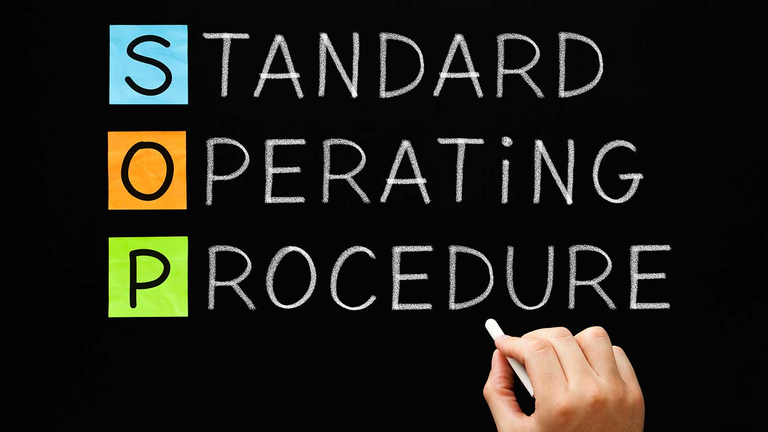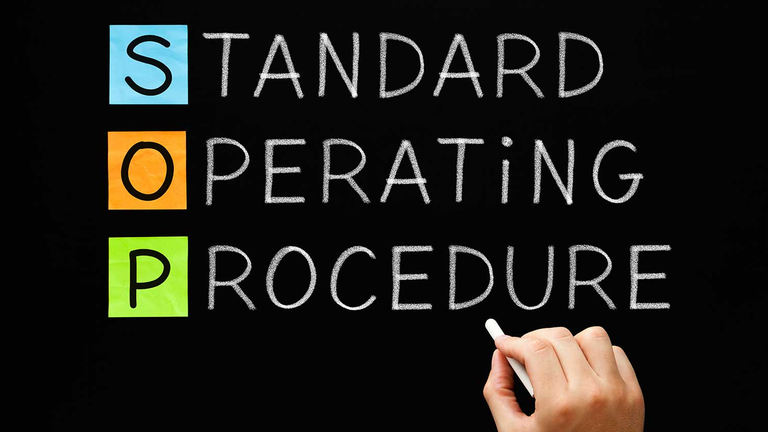KEEP IN TOUCH
Subscribe to our mailing list to get free tips on Data Protection and Cybersecurity updates weekly!







SOP for social media marketing is the use of social media platforms to connect with your audience to build your brand, increase sales, and drive website traffic. This involves publishing great content on your social media profiles, listening to and engaging your followers, analyzing your results, and running social media advertisements.
The major social media platforms (at the moment) are Facebook, Instagram, Twitter, LinkedIn, Pinterest, YouTube, and Snapchat.
There are also a range of social media management tools that help businesses to get the most out of the social media platforms listed above. For example, Buffer is a platform of social media management tools, which can help you achieve success with your social media marketing. Whether you want to build a brand or grow your business, we want to help you succeed.

It is a standard operating procedures are step-by-step instructions that describe how to perform a routine process. They should be brief, easy to understand and contain actionable steps that are simple follow.
Although there’s many reasons why SOP’s are important, let’s look at a few of the main ones:
They make your business run more efficiently: When you create effective SOPs, you ensure that every business process is executed exactly the same way, every time, no matter which person is doing the work. Without SOPs, projects are left to chance and chaos reigns.
They minimize the impact of turnover: If the details of a proprietary process in your company all reside within one employee’s head, that’s a huge risk. By documenting this process in a SOP, you protect your business in the off-chance that this employee was to leave or retire.
They improve accountability: When you use Flowster to manage your business processes, you have transparency and an audit trail into everything that your employees work on. You can see exactly how long it took various tasks to be completed, who did the work, and even be automatically notified by email when it’s done.
They enforce quality control: If your business has created a product or service that sells well and differentiates itself from your competitors, you’ll want to maintain a high standard of quality. SOP’s guide your employees and reduce the chance of errors or skipped steps that may impact the quality of your product. Standard operating procedures provide a blueprint for your staff that protects the integrity of whatever they’re creating.
They improve teamwork: Collaboration with your team is vital. When following a Standard Operating Procedure (SOP), team members can easily assign each other tasks, give due dates, upload files, and add comments to the work they’ve done. This keeps everyone in the loop and your business running at peak efficiency.
Also Read: 7 Principles of Personal Data Processing
Below are the 7 fundamental guide on SOP for social media marketing
Start by deciding what you want to accomplish on social media and let those results guide the formation of each goal. Setting goals will allow your organization to measure outcomes and track the progress of your social media best practices.
Common social media goals:
Setting your social media goals:
Using the SMART goal-setting method will allow you to establish goals that are specific, measurable, attainable, relevant, and timely. This is possibly one of the most well-circulated social media best practices, but one we believe remains as relevant today as it ever was.
First determine who your audience is, what their interests are, whether your business can fulfill their interests, and why they would want to do business with your brand.
Second, choose a specific goal metric that can be measured, such as a percentage increase of sales, revenue, or engagement.
Third, choose a number that is realistic. Ask yourself if the organization has the resources to reach the chosen number, and if not, what it would take to get there. It’s better to scale back and create accurate projections than to choose exaggerated metrics you can’t reach.
Fourth, make sure your chosen objective makes sense for your business and supports both the brand vision and core values.
Finally, create a timeline that can realistically be achieved. If necessary, break up large chunks of your goal into smaller monthly, weekly, and daily tasks.

When you choose which social platforms your brand will be active on, your decision should be based on the value and relevancy of each platform to your business. This social media best practice highlights the importance of deciding on a set of criteria that can guide your social process.
Social Media Platform Considerations:
Use the platform-by-platform breakdown below to help simplify your decision and checkout our in-depth blog post on choosing the best social media platform. As social media best practices go, choosing a relevant platform is one of the most important decisions you can make for your brand.
Facebook: With 1.86 billion active monthly users, Facebook is the largest and most popular social media platform. If you don’t mind a ton of competition, Facebook is the place to be. It also boasts an exceptional advertising platform.
Good for:
Twitter: At 319 million active monthly users, Twitter is almost six times smaller than Facebook but still carries a massive amount of influence. Tech-savvy, younger audiences flock to Twitter. If you’re looking for ways to capitalize on timely information sharing, Twitter is a great platform.
Good for:
Instagram: Instagram is growing year-over-year at an accelerated pace, now reaching 600 million active monthly users. With an audience that tends to skew slightly younger, Instagram is all about photos, graphics, and videos. If your brand has access to large amounts of custom visual content, Instagram is a great platform.
Good for:
Pinterest: With approximately 110 million active monthly users, Pinterest may sound small, but they have a fiercely loyal following. The audience is strongly skewed towards females, favors large pieces of visual content, and is great for product marketing.
Good for:
Google+: 300 million active monthly users isn’t bad, but Google+ users tend to join for SEO purposes and not for social ones. If your brand produces web content, such as blogs, ebooks, and webinars, Google+ provides an opportunity to improve SEO ranking.
Good for:
YouTube: With more than 1 billion users, YouTube is the only social platform that gives Facebook a run for its money size-wise and is the second largest search engine on the internet. Businesses that produce a lot of original video content can benefit from managing a YouTube account.
Good for:
LinkedIn: Just 25% of LinkedIn’s 450 million users are active each month. A true B2B social media platform, your brand would be wise to include a strategy for LinkedIn if you operate as a B2B organization.
Good for:
Including this on a list of social media best practices sounds a little too obvious at first, but it’s also too important to ignore, so here goes. When prospects, leads, and customers visit your brand’s social media profiles, they should be able to read your bio or visit the About page and find a summary of who the business is, what it does, how it can help them, and where they can find more information. This is also the perfect opportunity to provide a link to your website and include relevant hashtags.
Things to Include in your brand “About” section:
Visitors should be able to find your logo and company name as soon as they reach your account. Everything from your visuals to your messaging should convey your brand’s tone and values. Branding is one of the social media best practices rooted in the concept of improving the customer experience.
Ways to Brand Your Social Media Accounts:
A highly-targeted audience is one that has the potential to drive engagement and ultimately generate sales leads. Engaging with your audience provides a number of benefits to your brand.
Benefits of Engaging with Your Audience:
Your audience pays attention to the little details and so should you. Share content on a regular basis that speaks to your brand values. Images, videos, post copy, and all other types of content should be optimized for reach and quality.
Things to Check For:
Remember that you only have one chance to make a great first impression, so the quality of your visual elements needs to be perfect. A poorly sized cover photo or slightly pixelated profile image can result in negative brand association and loss of audience.
This is a combination of the past six social media best practices. You need to engage with followers on social media every day while posting high quality content on a consistent basis that builds an audience of brand advocates. You’ll also need to brand each account so it identifies as being part of your organization.
Additional Considerations:
If you keep these social media best practices in mind as you begin to build your social strategy, you’ll be well on your ways towards achieving your business goals.
Here’s the big picture thought to ponder. Maybe the primary barrier to scaling up your business into an ever larger and more energetic version of itself aren’t competitors but rather a failure to deliver products or services correctly and on time. In other words, organizational incompetence. SOP for social media marketing are GREAT at fixing that.